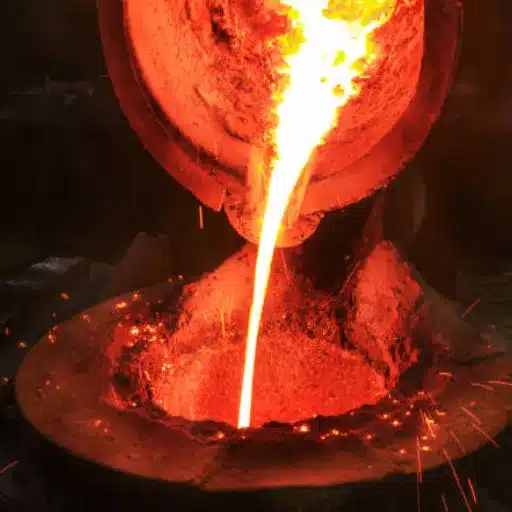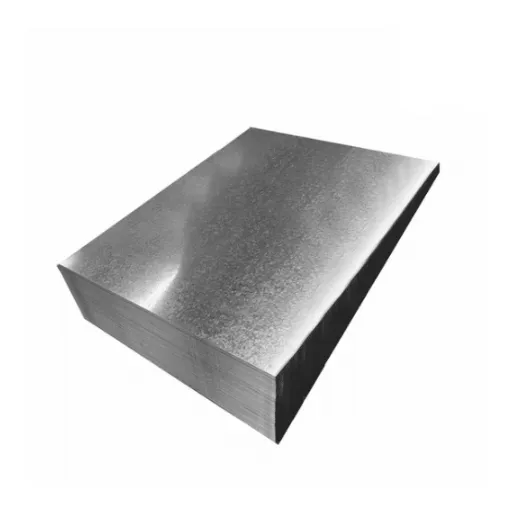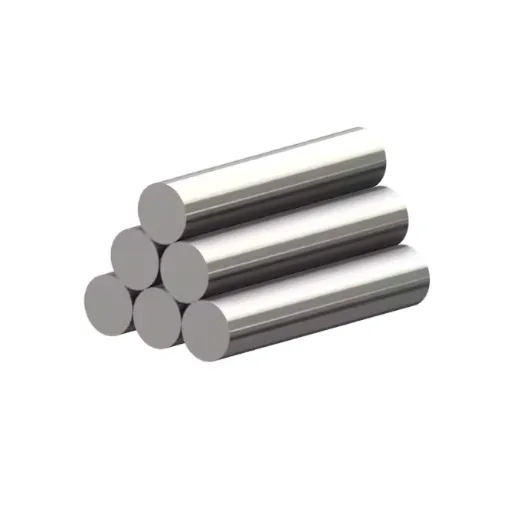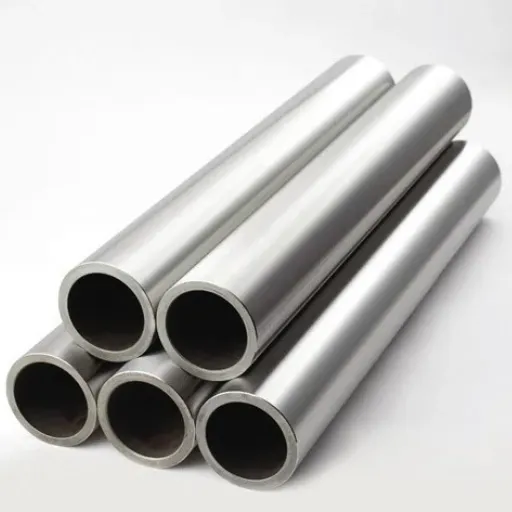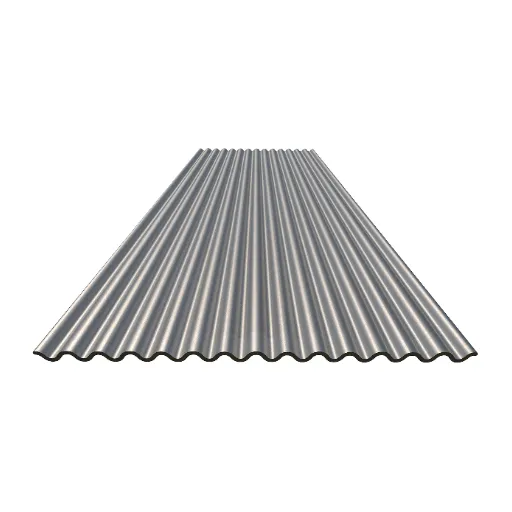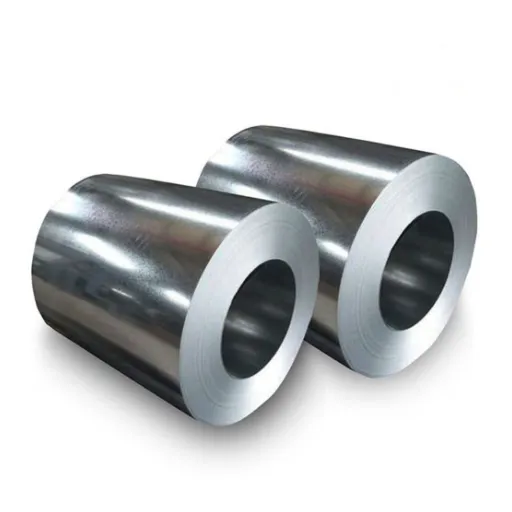SAE 1045 steel is a medium-carbon steel that is popular for its good strength, toughness, and wear resistance. A collection of industries make use of this type of steel and it is renowned for it’s strength, hardness, and wear resistance when properly treated. SAE 1045 steel is a good option in demanding applications requiring machines parts, shafts, and fasteners which need a reliable solution. In the remaining portion of this article, we elaborate the the characteristic, mechanical properties of SAE 1045 steel and its industrial application while also focusing on heat treatment processes. And so, we aim to provide our audience reasons surrounding this material’s popularity among manufacturers and engineers across the globe.
What is SAE 1045 Steel?
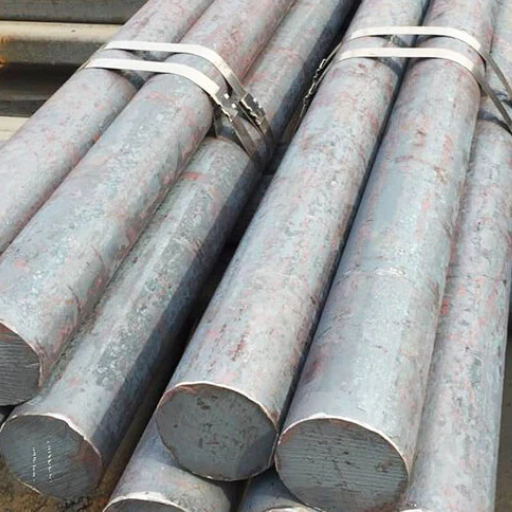
SAE 1045 steel is used in various industrial applications and in the construction of different kinds of machinery because of its superb strength. Commonly supplied in hot rolled or normalized forms, SAE 1045 steel finds applications in the fabrication of shafts, gears, axles, and other mechanically active parts. In comparison to other forms of steel, its wear resistance is commendable. Other than that, its ductility, machinability and ease of moldability also make it a favorable one among engineers. This makes it beneficial for general engineering and in various manufacturing processes.
Key Features of SAE 1045
- Medium Carbon Content
The factors of strength, any degree of hardness, and machinability achievable in SAE 1045 steel is due to the presence of carbon in the steel which contains approximately 0.45% carbon. This alloy is useful in myriad applications.
- High Tensile Strength
SAE 1045 has an tensile strength of 570 – 700 MPa which is still hot-rolled, which allows its use in demanding engineering applications.
- Enhanced Hardness
Brinell Hardness Range of 170 – 210 HB under normal conditions gives moderate wear resistance for components that are under a rub-down.
- Excellent Machinability
SAE 1045 has different machining processes which makes it cost efficient. It has a percent machinability of 64% when benchmarked with AISI 1112 steel.
- Heat Treatment Capability
The material responds to most heat treatments designed to increase surface hardness or tensile strength, such as quenching and tempering.
- Good Weldability
The weldability is only fair due to medium carbon content, but preheated and post-welded treated structural welds can enhance the welded joint for line-of-sight welding onto structural members.
These, along with its lower cost, are why SAE 1045 is popular in both industrial manufacturing and general-purpose applications.
Applications of 1045 Steel
Strength, toughness, and machinability all together position SAE 1045 steel as one of the most widely used materials in various industries. Here is the list of its applications:
- Automotive Components
1045 steel possesses a high tensile strength and wear resistance making it applicable in the manufacturing of connecting rods, crankshafts, gears, and even axles. For example, a yield strength of slightly under 310 MPa will enable it to endure mechanical stresses in a vehicle system.
- Machine Parts
1045 steel can also be used in the production of spindles, shafts, and couplings because of its excellent machinability. The high surface hardness developed after heat treatment further assures the steel’s durability under cyclic stress in machinery.
- Construction Materials
Because 1045 steel offers good mechanical properties such as heat treated tensile strength of about 565-745 MPa, it is also used in structural components like rails and beams, especially where precision and strength is demanded moderate.
- Agricultural Equipment
Another feature of 1045 steel is its wear resistance which makes it ideal for use in heavy-duty farming tools such as plows and disc harrows.
- Forging Applications
1045 Steel has good formability enabling it to be used in open-die and closed-die forging. This formability is utilized in forging rings as well as blocks and bars for components in industrial machines.
1045 steel is valuable in meeting the needs of challenging industrial and structural applications because of its strength.
What is the Chemical Composition of SAE 1045 Steel?
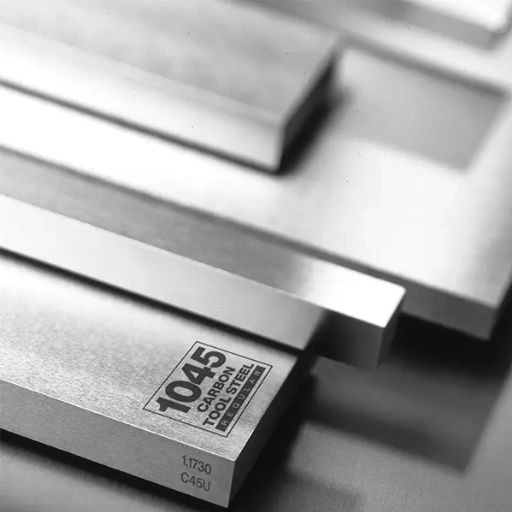
Steel is broken down into carbon and manganese. With a standard chemical composition of medium-carbon steel, 1045 steel can be further divided into:
- Carbon (C): 0.43% – 0.50%
- Manganese (Mn): 0.60% – 0.90%
- Phosphorus (P): Maximum 0.040%
- Sulfur (S): Maximum 0.050%
- Iron (Fe): Balance
The structural composition provides the steel a versatile strength, hardness, and machinability which supports various industrial requirements.
Elements in 1045 Carbon Steel
Specific elements present in SAE 1045 carbon steel give synergistic properties and make the alloy adaptable and effective in industrial applications:
- Carbon (C): The alloying carbon element with a composition of 0.43%- 0.50% improves hardness and strengthens the alloy. While Carbon increases tensile strength, it decreases ductility and weldability.
- Manganese (Mn): With Manganese being in the range of 0.60%- 0.90%, it improves the toughness while increasing the alloy’s wear and response to heat treatment. While serving as a deoxidizer, it improves the integrity of the alloy about one of its properties.
- Phosphorus (P): Phosphorus up to a maximum 0.040% improves machinability. However, due to promoting brittleness, is limited to that number.
- Sulfur (S): Sulfur is restricted to no more than 0.050%. Its primary purpose in this concentration is to enhance machinability. Too much of it may negatively impact the steel’s impact resistance and ductility.
- Iron (Fe): Iron makes up the rest of the composition and is in the form of a steel matrix. He provides basic properties such as magnetism and structural strength.
With the synergistic combination of these elements, SAE 1045 steel can achieve an optimal balance between mechanical and processing features, providing high utility in these sectors: automobile and heavy machinery manufacturing.
Carbon Content and Its Impact
The SAE 1045 steel has a carbon content of around 0.45% making it a medium carbon steel. This particular band of carbon is critical to the material’s behavior mechanically. Increased carbon content makes the steel harder and increases its tensile strength because more potent martensitic structures form during heat treatment. Nevertheless, this makes the steel less ductile and weldable when compared with low carbon steels. There is a trade-off in strength versus formability in this case.
Moreover, the carbon content also affects the machinability of the steel and its surface hardenability. The medium carbon composition of SAE 1045 makes it easy to quench and temper which results in much higher wear resistance and fatigue strength. This is especially important in the automotive and agricultural industries, where parts such as gears, shafts, and other forged parts of machinery need to withstand extreme stress without failing. Engineers can achieve optimal performance of an application for a given operational condition by accurately understanding the function of carbon at a molecular scale in crafting the heat treatment processes.
Comparison with Other Medium Carbon Steels
|
Parameter |
Steel AISI 1045 |
Steel AISI 1020 |
Steel AISI 4140 |
Steel AISI 4340 |
|---|---|---|---|---|
|
Carbon Content |
|
|
|
|
|
Tensile Strength |
~570 MPa |
~394 MPa |
~655 MPa |
~745 MPa |
|
Yield Strength |
~310 MPa |
~294 MPa |
~415 MPa |
~470 MPa |
|
Hardness (Brinell HB) |
~200 |
~120 |
~197 |
~217 |
|
Weldability |
Moderate |
High |
Moderate |
Low |
|
Machinability |
Good |
Excellent |
Good |
Fair |
|
Heat Treatment Capability |
Moderate |
Low |
Excellent |
Excellent |
|
Common Applications |
Shafts, gears |
Tubing, light structures |
Crankshafts, axles |
Heavy-duty components |
How does Heat Treatment affect SAE 1045 Steel?
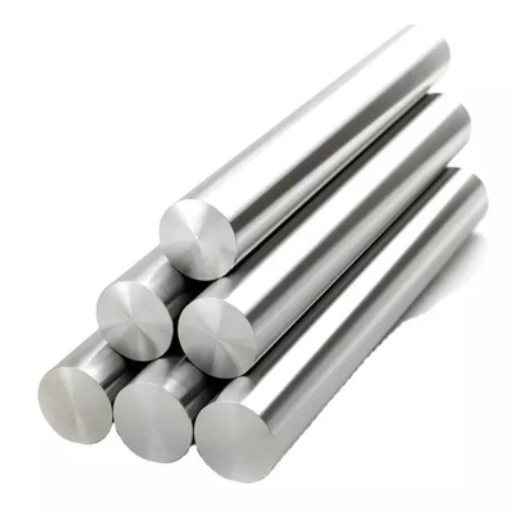
Heat treatment processes are very important because they can change the mechanical characteristics of SAE 1045 steel In other words, it can increase the performance qualities of the steel for different uses. After heat treatment processes, the hardness, strength and ductility of the steel can be optimized for engineering needs. For example, quenching followed by tempering improves tensile strength, toughness, and wear resistance but keeps good toughness. Normalizing improves machinability and refines grain structure which increases strength. These treatments make SAE 1045 versatile for equipment that needs structural strength and better mechanical performance.
Types of Heat Treatment for 1045 Steel
- Annealing
A steam treatment of 1045 steel is done at 1450°F to 1600°F (790°C to 870°C) where it is then slowly cooled in a furnace. Inner stresses are relieved and enhanced, alongside reduced hardness which improves machining. This is beneficial in materials that require a lot of form work or machining.
- Normalizing
Steel is normalized at its microstructure temperatures (1650°F to 1700°F) which is approximately 900°C to 925°C while air cooling to room temperature. This process refines toughness providing the material with balanced reinforcement. The microstructure steel gains during the process of normalization adds strength and ductility which outperforms untreated steel.
- Quenching and Tempering
By heating the steel to the austenitizing temperature (around 1500°F or 815°C) and rapidly cooling it (quenching) using oil or water, the hardness and strength of 1045 steel are significantly increased. Following quenching, tempering is carried out by reheating the steel to a temperature typically in the range of 400°F to 1200°F (200°C to 650°C), depending on the desired balance of hardness and ductility. This stage reduces brittleness while maintaining enhanced mechanical properties, making it suitable for high-strength applications.
- Carburizing
Carburizing is a thermochemical process which consists of the heating of metals in a carbon-rich atmosphere to around 1600°F – 1700°F (870°C – 925°C), which temperature brings the surface level to infuse cyclopropane. Hardness on the surface is improved as carbon diffuses, which is added on a steel surface, while the center remains ductile and tough. This type of thermochemical treatment is done on gears, shafts and other components which have a surface that wears at a high rate.
In all these methods of heat treatment, performing several of them at once or customizing them works best to alter 1045 steel’s performance. In turn, the 1045 steel is helpful in many fields and areas due to these alterations.
Advantages of Annealing SAE 1045
- Improved Machinability:
By aiding in softer cuts, shaping and drilling during machining processes, annealing decreases tensile strength and overall hardness. This in turn results in less tool wear and expands tool life during processing.
- Enhanced Dimensional Stability:
Relieving internal stresses from earlier processes like machining improves dimensional accuracy and stability. This is important for components with tight tolerances during manufacturing.
- Optimized Mechanical Properties:
Annealing helps improves steel 1045 grade into being able to withstand impact loads with higher performance levels. This boosts the toughness and impact resistance making SAE 1045 steel highly efficient under dynamic loads.
- Ease of Subsequent Heat Treatments:
Increases ease of subsequent heat treatments like quenching and tempering is achieved through softening the material via annealing processes. This adds enables greater control over the final desired mechanical properties based on the application.
- Improved Formability:
The reduction in hardness due to annealing makes the material easier to deform during forming operations and bending, rolling, or drastic changes without breaking, which is helpful for the material.
With annealing benefits of SAE 1045 steel, the automotive, construction, and agricultural machinery industries have performance and reliability needs that are intensified.
What are the Mechanical Properties of SAE 1045 Steel?
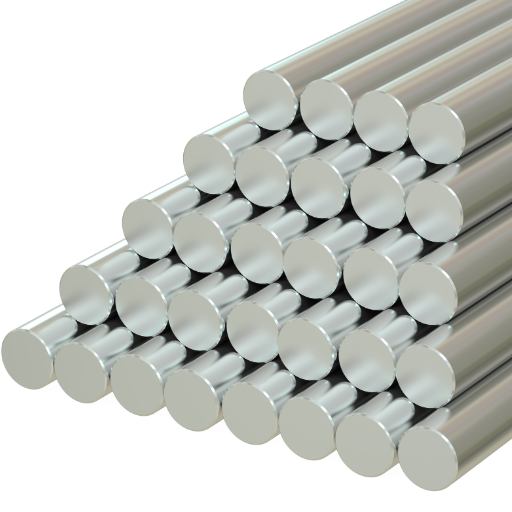
SAE 1045 steel shows threats in mechanical characteristics that are an asset to numerous industries. Its main features include:
- Tensile Strength: The impact yield strength and find a balance falls within mild tension. According to standardized testing, the tensile strength can reach extremes of around 570 Mpa to 700 Mpa. All differences resulting from distinct heat treatments.
- Yield Strength: Maintaining the spaced intervals of a stretch returns to its original gravimetric measurement offset by 310 MPa to 450 MPa, shows moderate capacity stretch resistance.
- Hardness: Normalized SAE 1045 steel has a documented BHN between 170 to 210. This value increases with tempered quenching.
- Elongation: Shows 16-22% elongation over two inches, indicating moderate ductility.
- Impact Resistance: Exhibits strong compressive strength, especially under heat treatment, and resists breaking under loads which improves impact resistance.
SAE 1045 steel’s machinability and significant toughness make it dominate in the production of harden parts, component gears, and shafts.
Tensile Strength and Hardness
SAE 1045 steel is relatively easy to machine and with a yield of 570 to 700 MPa, makes this steel ideal in the construction and mechanical industry. This medium carbon steel is noted for high tensile strength and can go beyond 850 MPa if treated with quenching and tempering
SAE 1045 Steel’s hardness levels are directly attributed to the level of heat treatment that is applied. In normalized conditions, hardness values tell a different story and fall between 170 to 210 Brinell Hardness (BHN). After heat treatments, hardness of 55 HRC (Rockwell Hardness) is achievable. These combinations give SAE 1045 steel a high tensile strength, coupled with a changeable hardness, making it a go-to steel for components needed for harsh wear and precision, like crankshafts and bolts, as well as Industrial Machine Parts.
Impact Resistance and Wear Properties
SAE 1045 steel has a medium carbon content, which allows a degree of heat treatment, making it tough, and aids with impact resistance. Specifically, the impact resistance the material possesses with regard to sudden shocks and mechanical impacts is beneficial in areas with dynamic loading. The wear characteristics of U 1045 are improved due to surface treatments that increase surface hardness while keeping the core softer, such as hardening or carburizing. The carburized layers, for instance, increase abrasive wear resistance beyond 60 HRC in harsh contact applications like gears and heavy-duty pins. Moreover, the uniform microstructure of the steel provides consistent performance under repetitive cycles of loading which significantly aids the wear resistance after long periods of operation. Together, these properties make SAE 1045 a dependable steel grade for rugged machine components.
What are the Applications of SAE 1045 Steel?
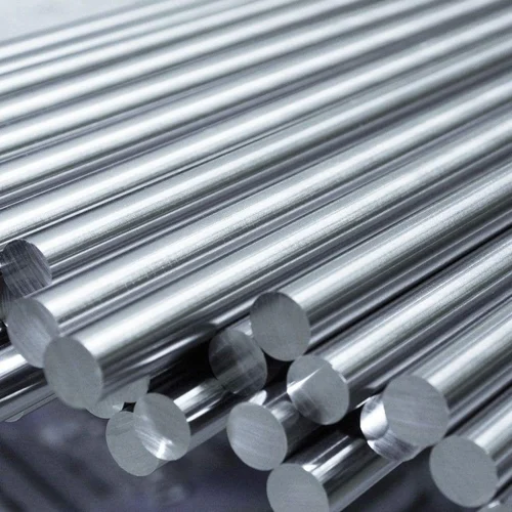
Common Uses in Industrial Applications
- Automotive Industry
-
- Gears and Shafts: Automotive components such as shafts and gears. These alloy steels are highly abrasive with their HRC 60 hardness. Gears experience extreme torque reliability.
- Crankshafts: Automotive workloads utilize chromium molybdenum steels for their high fatigue resistance. This is observed in the production of gyrating shafts utilized in light and heavy-duty engines.
- Axles: Automotive axles are made from alloy steels with a tensile strength over 850 MPa to resist cyclic loading and enhance the stability of the vehicle.
- Heavy Machinery
- Couplings and Links: These materials’ machinability and toughness ease their use as couplings and mechanical links, which need precision and endurance at extreme operational stresses.
- Bolts and Fasteners: The need for heavy machineries comes the requirenment of high strength bolts and fasteners. These are made by heat treated alloy steels which have yield strengths above 500 Mpa.
- Tool Manufacturing
- Cutting and Drilling Tools: High Speed Steels and Tungsten Carbid Alloys are used to make cutting, drilling and milling tools due to there hardness and resistncae to thermal deformation.
- Precision Instruments: The reliability and resistence to wear of the materials used assures precision measurement tools such as calipers, micrometers and gauges are not only accurate but also shatterproof.
- Energy Sector
- Oil and Gas Components: Concerning oil industry, tubular goods, drill collars and valves are manufactured out of steels of alloy resistant to corrosion for aggressive environment and high pressures.
- Power Generation Systems: The shafts and blades of the turbines are made of high temperature and rotation stress resistant materials so they can be used at elevated temperatures with high rotational speed.
Furthermore, these industrial parts are designed and made by composing select materials that target endurance and performance, thus improving their efficiency and service life in the designated field.
Benefits of Using SAE 1045 in Manufacturing
- High Strength and Toughness
A good example is SAE 1045, which is a medium carbon steel which provides an adequate balance of toughness and strength. It is used for products which need some level of impact resistance. Its tensile strength also provides reasonable numbers, sitting between 570 and 700 MPa (82,655 and 101,526 psi).
- Machinability
SAE 1045 performs well in casting turning, milling and drilling as well. Once annealed or normalized, its machinability improves, providing reduced production times in the manufacturing processes as well as lower cost of operational resources while maintaining the integrity of the material.
- Wear Resistance
SAE 1045 does have poor surface properties when it comes to hardening. Heat treatment helps with this problem by increasing surface hardness, helping durability for wear and tear. This becomes extremely important with the manufacturing of gears and axles where numerous parts need to withstand mechanical stress.
- Versatility in Heat Treatment
SAE 1045 can also be quenced and tempered to have varying mechanical properties depending on the intended purpose. This flexibility is beneficial during the manufacturers when they are aiming to change performance characteristics like hardness and rigidity.
Taking advantage of these benefits, manufacturers using SAE 1045 steel optimize production efficiency and the quality of finished components. It remains one of the most used materials in industries because it sustains mechanical strength, is economically feasible, and is adaptable.
Reference Sources
-
Fracture toughness of borided AISI 1045 steel – A study on the fracture toughness of iron borides formed on AISI 1045 steel using cross-sectional scratch tests.
-
Deep cryo treated tungsten carbide tools on AISI 1045 steel – Research on how deep cryogenic treatment enhances wear resistance and machining performance.
-
(PDF) Hot Drilling of SAE 1045 Steel Through Forging – A theoretical-experimental study proposing innovative manufacturing approaches for agricultural machinery.
-
1045 Steel Applications: A Comprehensive In-Depth Guide – An overview of the applications and properties of 1045 steel.
-
StressLife: A Short-Time Approach for the Determination of Material Response – A comparison of SAE 1045 steel’s material response with other steel types.
Frequently Asked Questions (FAQs)
Q: What is SAE 1045 steel and what are its main characteristics?
A: SAE 1045 steel is a medium carbon steel known for its good machinability, strength, and impact properties. It is commonly used in various applications due to its balance of strength and ductility.
Q: What are the thermal properties of SAE 1045 steel?
A: The thermal properties of SAE 1045 steel include a thermal conductivity of approximately 40 W/m·K and a specific heat capacity of around 0.46 J/g·K, which makes it suitable for applications where thermal stability is important.
Q: How is SAE 1045 steel typically supplied?
A: SAE 1045 steel is commonly available in various steel supply forms, including steel bar, steel plate, and cold drawn shapes, providing versatility for different manufacturing processes.
Q: What is the recommended steel heat treatment for SAE 1045 steel?
A: The recommended steel heat treatment for SAE 1045 steel typically involves quenching and tempering heat treatment to enhance its high strength and impact properties, making it suitable for demanding applications.
Q: How does SAE 1045 steel compare to 4140 steel?
A: SAE 1045 steel is a plain carbon steel, while 4140 steel is an alloy steel that contains chromium and molybdenum, providing additional hardness and wear resistance. As a result, 1045 and 4140 steel serve different applications based on their material properties.
Q: What are the common applications of AISI 1045 carbon steel?
A: AISI 1045 carbon steel is used in various applications, including machinery parts, axles, shafts, and gears, due to its good machinability and strength.
Q: What is the significance of holding time in the heat treatment of SAE 1045 steel?
A: Holding time during the heat treatment of SAE 1045 steel is critical as it affects the uniformity of hardness and the transformation of the microstructure, ultimately influencing the final material properties.
Q: Can SAE 1045 steel be forged, and if so, what considerations should be taken into account?
A: Yes, SAE 1045 steel can be forged. It is important to consider the temperature and techniques used during forging to ensure the desired material properties are achieved while minimizing defects.
Q: What is the chemical makeup of AISI 1045 carbon steel?
A: AISI 1045 carbon steel typically contains 0.43% to 0.50% carbon, along with small amounts of manganese, silicon, and other elements, which contribute to its mechanical properties and performance in various applications.

